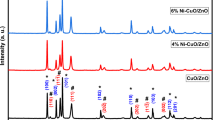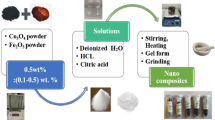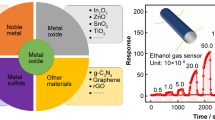Abstract
The n–n heterojunction is formed at the interfaces of FeVO4 and ZnO under hydrothermal conditions to increase the mobility of electrons and to decrease the barrier of oxygen activation. The results from X-ray powder diffraction and X-ray photoelectron spectroscopy analyses confirm the co-existence of the FeVO4 and ZnO phases in the composite. The formation of n–n heterojunction and electron transfer behavior are explored by applying electrochemical techniques and corresponding simulation calculation. The FeVO4/ZnO (Fe:Zn = 1:0.5) sensor shows a high response value of Sg = 42 at 300 °C, excellent selectivity, fast response, stable, and superior sensitivity for ethanol detection. The effect of the formed n–n heterojunction on enhancing the gas sensitivity for detecting ethanol is discussed by electron depletion theory. When the gas atmosphere is changed from air to ethanol gas, the depletion layer on the sensor surface is also changed significantly, altering the macroscopic resistance of the material. This work offers a new mechanistic understanding of the role of n–n heterojunction in detecting target gases and paves the way for designing excellent selectivity, fast response, and stable sensors based on n–n heterojunctions.









Similar content being viewed by others
References
Aguilera-Ruiz E, Garcia-Perez UM, de la Garza-Galvan M (2015) Efficiency of Cu2O/BiVO4 particles prepared with a new soft procedure on the degradation of dyes under visible-light irradiation. Appl Surf Sci 328:361–367
Balamurugan M, Yun G, Ahn KS, Kang SH (2017) Revealing the beneficial effects of FeVO4 nanoshell layer on the BiVO4 inverse opal core layer for photoelectrochemical water oxidation. J Phys Chem 121:7625–7634
Banik R, Lee DY, Gweon DG (2005) A high-speed miniature screening gaschromatograph with flame ionization detector. J Mech Sci Technol 19:2197–2204
Barsan N, Koziej D, Weimar U (2007) Metal oxide-based gas sensor research: how to? Sens Actuators B 121:18–35
Cao F, Li C, Li M (2018) Direct growth of Al-doped ZnO ultrathin nanosheets on electrode for ethanol gas sensor application. Appl Surf Sci 447:173–181
Cheong SW, Mostovoy M (2007) Multiferroics: a magnetic twist for ferroelectricity. Nat Mater 6:13–20
Choi SW, Katoch A, Sun GJ (2013) Synthesis and gas sensing performance of ZnO-SnO2 nanofiber-nanowire stem-branch heterostructure. Sens Actuators B 181:787–794
Deng J, Jiang J, Zhang Y, Lin X (2008) FeVO4 as a highly active heterogeneous Fenton-like catalyst towards the degradation of Orange. Appl Catal B 84:468–473
Deng J, Yu B, Lou Z (2013) Facile synthesis and enhanced ethanol sensing properties of the brush-like ZnO-TiO2 heterojunctions nanofibers. Sens Actuators B 184:21–26
Dixit A, Lawes G (2009) Development of electrical polarization at an antiferromagnetic transition in FeVO4. J Phys Condens Matter 21:456003
Gorczyca I, Wierzbowska M, Jarosz ID (2020) Rocksalt ZnMgO alloys for ultraviolet applications: origin of band-gap fluctuations and direct-indirect transition. Phys Rev B 102:079903
Hemmati S, Firooz AA, Khodadadi AA (2011) Nanostructured SnO2-ZnO sensor: highly sensitive and selective to ethanol. Sens Actuators B 160:1298–1303
Jia X, Fan H (2010) Preparation and ethanol sensing properties of the superstructure SnO2/ZnO composite via alcohol-assisted hydrothermal route. Mater Res Bull 45:1496–1500
Ju DX, Xu HY, Qiu ZW, Zhang ZC, Wang JQ, Cao BQ (2015) Near room temperature, fast-response, and highly sensitive triethylamine sensor assembled with Au-loaded ZnO/SnO2 Core-shell nanorods on flat alumina substrates. ACS Appl Mater Interfaces 7:19163–19171
Kim HJ, Lee JH (2014) Highly sensitive and selective gas sensors using p-type oxide semiconductors: overview. Sens Actuators B 192:607–627
Kumar A, Kumar A, Sharma G (2017) Sustainable nano-hybrids of magnetic biochar supported g-C3N4/FeVO4 for solar powered degradation of noxious pollutants synergism of adsorption, photocatalysis and photo-ozonation. J Cleaner Prod 165:431–451
Lehnen T, Valldor M (2014) Hydrothermally grown porous FeVO4 nanorods and their integration as active material in gas-senses. J Mater Chem A 2:1862–1868
Li G, Zhang X, Lu H (2019) Ethanol sensing properties and reduced sensor resistance using porous Nb2O5-TiO2n-n junction nanofibers. Sens Actuators B 283:602–612
Lin CY, Fang YY, Lin CW (2010) Fabrication of NOx gas sensor using In2O3-ZnO composite films. Sens Actuators B 146:28–34
Liu ZW, Liu B, Xie WY, Li H, Zhou R, Li QH, Wang TH (2016) Enhanced selective acetone sensing characteristics based on Co-doped WO3 hierarchical flower-like nanostructures assembled with nanoplates. Sens Actuators B 235:614–621
Liu C, Lu HB, Zhang JN, Gao JZ (2018) Crystal facet-dependent p-type and n-type sensing responses of TiO2 nanocrystals. Sens Actuators B 263:557–567
Luan J, Pan B, Paz Y, Li Y, Wu X, Zou Z (2009) Structural, photophysical and photocatalytic properties of new Bi2SbVO7 under visible light irradiation. Phys Chem Chem Phys 11:6289–6298
Nie J, Zhu G (2019) Pd0 nanocluster-modified porous FeVO4 nanorods with selective gas sensing property for benzyl alcohol detection. Mater Lett 241:47–50
Park JY, Choi SW, Lee JW (2009) Synthesis and gas sensing properties of TiO2-ZnO core-shell nanofibers. J Am Ceram Soc 92:2551–2554
Park JA, Moon J, Lee SJ (2010) SnO-ZnO hybrid nanofibers-based highly sensitive nitrogen dioxides sensor. Sens Actuators B 145:592–595
Park S, An S, Ko H (2014) Enhanced ethanol sensing properties of TiO2/ZnO core-shell nanorods sensor. Appl Phys A 115:1223–1229
Poizot P, Baudrin E, Laruelle S (2000) Low temperature synthesis and electrochemical performance of crystallized FeVO4 center dot 1.1 H2O. Solid State Ion 138:31–40
Prashant V, Kama Nada M (1990) Col1loidal semiconductors as photocatalysts for solar energy conversion. Sol Energy 44:83–98
Shad M, Yeganeh M, Nouri A (2013) Salmasifar, wet-chemical synthesis and electrochemical properties of Ce-doped FeVO4 for use as new anode material in Li-ion batteries. J Inorg Organomet Polym Mater 23:1226–1232
Shen JY, Zhang L, Ren J, Wang JC, Yao HC (2017) Highly enhanced acetone sensing performance of porous C-doped WO3 hollow spheres by carbon spheres as templates. Sens Actuators B 239:597–607
Shen JY, Wang MD, Wang YF (2018) Iron and carbon codoped WO3 with hierarchical walnut-like microstructure for highly sensitive and selective acetone sensor. Sens Actuators B 256:27–37
Su J, Zou XX, Li GD, Wei X, Yan C, Wang YN, Zhao J, Zhou LJ, Chen JS (2011) Macroporous V2O5-BiVO4 composites: effect of heterojunction on the behavior of photogenerated charge. J Phys Chem C 115:8064–8071
Wang HQ, Wu ZB, Liu Y (2009) A simple two-step template approach for preparing carbon-doped mesoporous TiO2 hollow microspheres. J Phys Chem C 113:13317–13324
Xu Y, Ma T, Liu X (2019) Heterostructures of hematite-sensitized W18O49 hollow spheres for improved acetone detection with ultralow detection limit. Sens Actuators B 288:432–441
Yao MS, Tang WX, Wang GE (2016) MOF thin film-coated metal oxide nanowire array: significantly improved chemiresistor sensor performance. Adv Mater 28:5229–5234
Zeng Y, Zhang T, Wang L (2009) Enhanced toluene sensing characteristics of TiO2-doped flowerlike ZnO nanostructures. Sens Actuators B 140:73–78
Zhang ZY, Shao CL, Li XH, Zhang L, Xue HM, Wang CH, Liu YC (2010) Electrospun nanofibers of ZnO-SnO2 heterojunction with high photocatalytic activity. J Phys Chem C 114:7920–7925
Zhang J, Liu X, Neri G, Pinna N (2016) Nanostructured materials for room-temperature gas sensors. Adv Mater 28:795–831
Zhang JN, Lu HB, Yan C, Yang ZB, Zhu GQ, Gao JZ (2018) Fabrication of conductive graphene oxide-WO3 composite nanofibers by electrospinning and their enhanced acetone gas sensing properties. Sens Actuators B 264:128–138
Zhou X, Peng W, Wang C, Hu X, Li X, Sun P (2014) Porous ZnO/ZnCo2O4 hollow spheres: synthesis, characterization, and application in gas sensor. J Matter Chem A 2:17683–17690
Zhou X, Liu J, Wang C, Sun P, Hu X, Li X (2015a) Highly sensitive acetone gas sensor based on porous ZnFe2O4 nanospheres. Sens Actuators B 206:577–583
Zhou X, Li X, Sun H, Sun P, Liang X, Liu F (2015b) Nanosheet-assembled ZnFe2O4 hollow microspheres for high-sensitive acetone sensor. ACS Appl Mater Interfaces 7:15414–15421
Acknowledgements
This work was supported by the National Natural Science Foundation of China (Grant no. 51772183), the Key Research and Development Program of Shaanxi Province (Grant no. 2018ZDCXL-SF-02-04), and the Science and Technology Planning of Guangdong Province (Grant no. 2020B1212060055).
Funding
The authors declare no competing financial interest.
Author information
Authors and Affiliations
Contributions
GQZ designed the project; YCO and JHP performed the experiments and data analysis; GQZ, RLZ, and JZG contributed to the theoretical analysis; YCO, GQZ, FCZ, and MH wrote the paper. All authors contributed to the general discussion.
Corresponding author
Ethics declarations
Conflict of interest
All authors certify that they have no affiliations with or involvement in any organization or entity with any financial interest or non-financial interest in the subject matter or materials discussed in this manuscript.
Additional information
Publisher's Note
Springer Nature remains neutral with regard to jurisdictional claims in published maps and institutional affiliations.
Supplementary Information
Below is the link to the electronic supplementary material.
Rights and permissions
About this article
Cite this article
Ou, Y., Zhu, R., Peng, J. et al. Formation of FeVO4/ZnO n–n heterojunction with enhanced sensing properties for ethanol. Appl Nanosci 13, 465–474 (2023). https://doi.org/10.1007/s13204-021-01794-8
Received:
Accepted:
Published:
Issue Date:
DOI: https://doi.org/10.1007/s13204-021-01794-8




